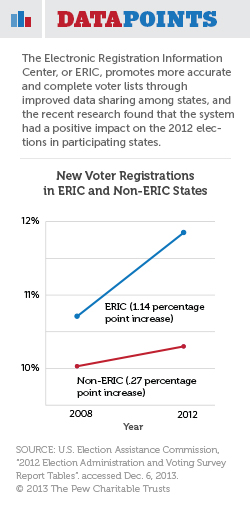Data Show Improvements in Election Administration in States Using ERIC
A recent report by RTI International evaluates the Electronic Registration Information Center, or ERIC, a partnership between seven pioneering states—Colorado, Delaware, Maryland, Nevada, Utah, Virginia, and Washington—facilitated by The Pew Charitable Trusts. ERIC promotes more accurate and complete voter lists through improved data sharing among states, and the RTI research found that the system had a positive impact on the 2012 elections in participating states.
Washington—facilitated by The Pew Charitable Trusts. ERIC promotes more accurate and complete voter lists through improved data sharing among states, and the RTI research found that the system had a positive impact on the 2012 elections in participating states.
ERIC compares participating states’ voter and Department of Motor Vehicle records, and looks at data from the U.S. Postal Service and death records from the Social Security Administration. This allows ERIC states to identify voters who moved, died, or have duplicate registrations, and those who may be eligible to vote but are unregistered. In 2012, the seven ERIC states used these data to send postcards to 5,701,048 eligible but unregistered individuals inviting them to register. As a result of this outreach, 5.4 percent of those contacted registered to vote.
The RTI report finds that from 2008 to 2012, ERIC states:
- Increased their new-voter registration rates by 1.14 percentage points, compared with just 0.27 points in non-ERIC states.
- Experienced a 3.39-point decrease in the rate of individuals citing registration problems as their reason for not voting, compared with a 0.57-point decline in non-ERIC states.
- Had an increase of just 0.10 percentage points in the use of provisional ballots—which are often issued to voters with problematic registration status; in non-ERIC states, the use of these ballots grew by 0.36 points.
Election officials interviewed in the RTI report expressed confidence that the ERIC data exchange would continue to improve the accuracy and credibility of their voter lists and would reduce long-term costs. For instance, Utah election officials were excited about using ERIC to automate some of their voter registration mailings. According to the report, “This would streamline list maintenance for the counties, freeing them to focus on other pressing activities.” Additional research is already underway to evaluate other effects of participation in ERIC.
To learn more about ERIC, watch this animated video.
Follow us on Twitter using #electiondata and get the latest data dispatches, research, and news by subscribing today.











